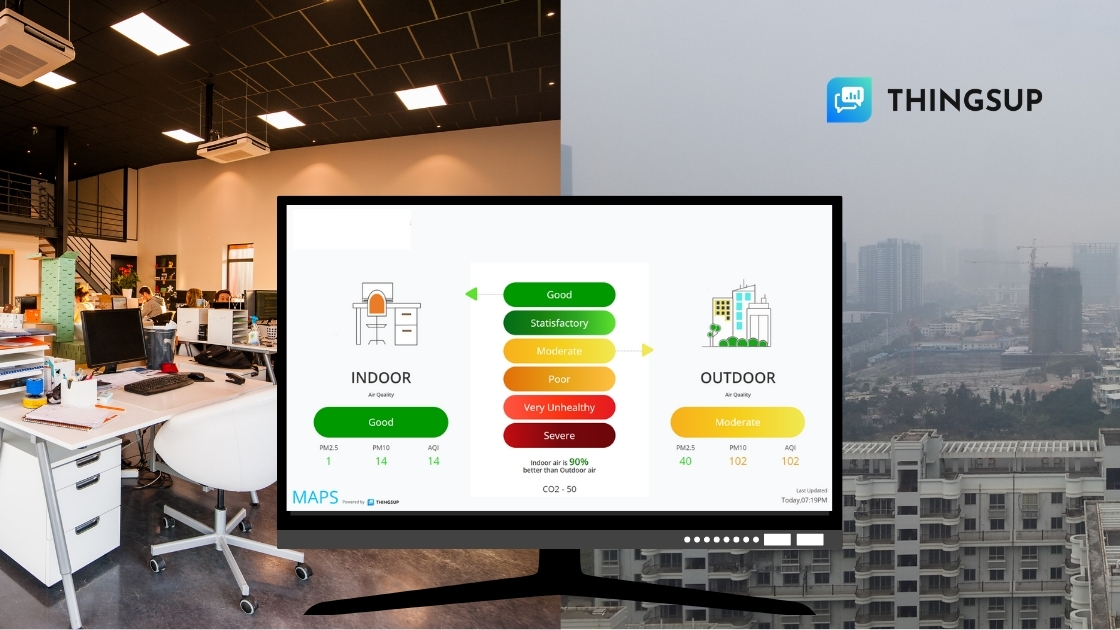In today’s world, the importance of indoor air quality (IAQ) cannot be overstated. With an increasing focus on health and wellness, individuals are becoming more conscious of the air they breathe, especially in indoor environments. HVAC (Heating, Ventilation, and Air Conditioning) systems play a pivotal role in maintaining indoor air quality, ensuring a comfortable and healthy atmosphere for occupants. In this blog, we delve into how HVAC manufacturers are utilizing IoT-enabled monitors to compare indoor and outdoor Air Quality Index (AQI) levels in real-time. By merging data from both realms, HVAC manufacturers can make informed decisions, implement effective strategies, and contribute to the overall well-being of building occupants.
Significance of Indoor Air Quality
Indoor air quality directly impacts the health, productivity, and comfort of occupants. Poor IAQ has been linked to various health issues, including allergies, asthma, respiratory infections, and even cognitive impairments. In recent years, the demand for healthier indoor environments has prompted HVAC manufacturers to focus on integrating advanced technologies to monitor and improve IAQ.
The Role of IoT-Enabled Monitors
Internet of Things (IoT) technology has revolutionized the way we collect, analyze, and utilize data. IoT-enabled monitors are compact devices equipped with sensors that measure various air pollutants, such as volatile organic compounds (VOCs), particulate matter (PM2.5 and PM10), carbon dioxide (CO2), and more. These monitors are strategically placed indoors and outdoors to provide a comprehensive picture of air quality conditions.
Real-Time Comparison of Indoor and Outdoor AQIs
One of the key advantages of IoT-enabled monitors is their ability to compare indoor and outdoor AQIs in real-time. By simultaneously tracking air quality levels both inside and outside a building, manufacturers can identify potential sources of pollution, assess the effectiveness of ventilation systems, and implement targeted interventions.
Benefits for HVAC Manufacturers
1. Informed Decision-Making:
IoT-enabled monitors provide manufacturers with accurate and up-to-date data, enabling them to make informed decisions regarding ventilation strategies, filter replacements, and system upgrades.
2. Proactive Maintenance:
By monitoring IAQ parameters in real-time, manufacturers can detect anomalies and malfunctions promptly. This proactive approach to maintenance enhances system reliability and extends the lifespan of HVAC equipment.
3. Compliance with Regulations:
Many regions have established guidelines and regulations pertaining to indoor air quality. IoT-enabled monitors help manufacturers ensure compliance with these standards and avoid potential penalties.
4. Customer Satisfaction:
Delivering a healthy and comfortable indoor environment enhances customer satisfaction and builds brand loyalty. Manufacturers can showcase their commitment to IAQ by leveraging real-time data to optimize system performance.
5. Data-Driven Insights:
The data collected from IoT-enabled monitors can be analyzed to identify trends, patterns, and correlations between indoor and outdoor AQIs. This knowledge empowers manufacturers to refine their products and strategies continually.
According to the Environmental Protection Agency (EPA), indoor air can be two to five times more polluted than outdoor air. Additionally:
- 90% of people’s time is spent indoors, emphasizing the significance of IAQ.
- Poor IAQ costs businesses an estimated $60 billion annually in lost productivity and increased medical expenses.
- The World Health Organization (WHO) attributes 4.3 million premature deaths per year to indoor air pollution.
Conclusion
In the pursuit of healthier indoor environments, HVAC manufacturers are turning to IoT-enabled monitors to bridge the gap between indoor and outdoor AQIs. The integration of real-time data empowers manufacturers to optimize HVAC systems, enhance occupant well-being, and meet regulatory standards. As technology continues to advance, the synergy between IoT and IAQ promises a future where every breath we take indoors is one of quality, comfort, and vitality.






